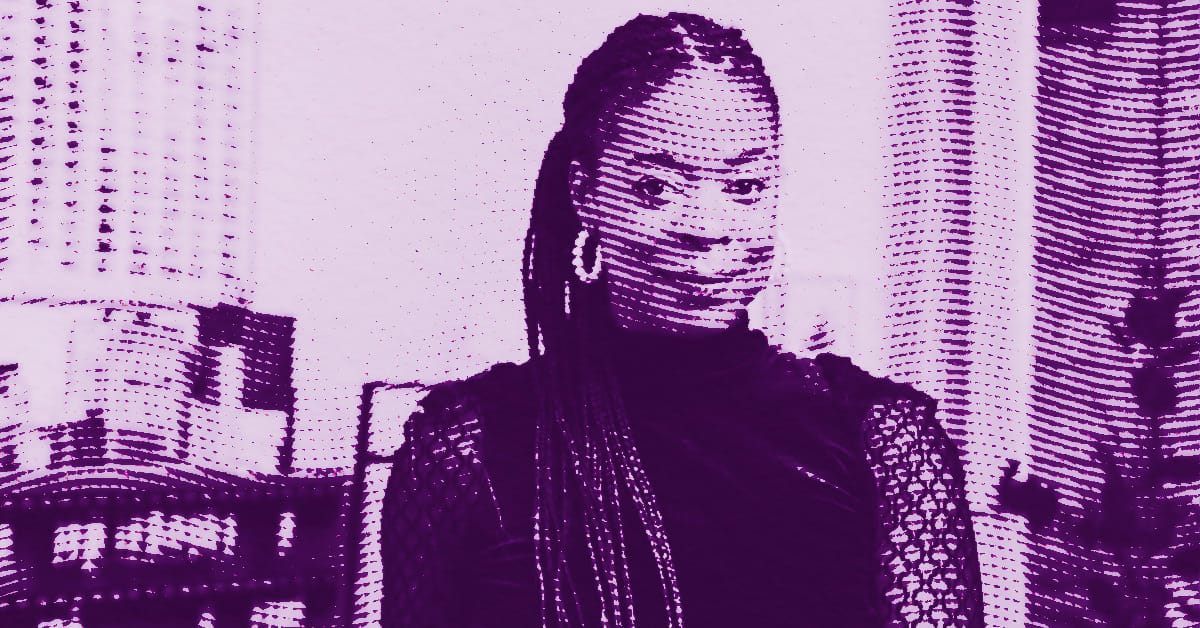Listen to me carefully, you bunch of snobs: if you still think figurative painting is a closed case, a dusty relic of the last century, then you clearly haven’t laid eyes on Danielle Mckinney’s work. This artist born in 1981 in Montgomery, Alabama, trained in photography before reclaiming painting during the 2020 lockdowns, does not produce mere portraits. She constructs sanctuaries, closed rooms where time suspends, where the Black women she portrays finally grant themselves this scandalous luxury: doing absolutely nothing.
For it is precisely there that Mckinney’s quiet genius resides. In a world saturated with images that scream, that claim, that perform identity to exhaustion, she chooses the whisper. Her small-format canvases, often no larger than a sheet of paper, radiate power inversely proportional to their size. They do not shout their presence; they impose it through the density of their silence. The women she paints smoke, sleep, read, daydream, occupy domestic spaces bathed in thick shadows from which emerge touches of saturated color: a blood-red fingernail, an ochre cushion, a green light filtering through blinds. These details are never gratuitous. They constitute the emotional coordinates of an intimate map that the artist draws with surgical precision.
Mckinney works from a black background, thus overturning the academic convention of the white canvas. This technical choice is not merely aesthetic: it is philosophical. Black becomes the matrix from which figures emerge, like photographic apparitions in a darkroom. The artist, who earned her master’s degree in photography from Parsons School of Design in 2013, cannot undo this initial training. She paints with the eye of a photographer, building her compositions from collages of images gathered from vintage magazines from the 1930s to the 1970s, on Pinterest, or in old photographs. This working method recalls the shoeboxes she made as a child, placing female figurines in carefully painted settings. The artist has never left this playful and protective territory of miniature world-building. She remains there, transforming each canvas into a psychological diorama where subtle inner dramas unfold.
Sociologically, Mckinney’s work fits into a specific and necessary historical moment. When she states: “I have never seen a Black woman with dark skin in a magazine” [1], she points out a structural absence in Western visual representation. This absence is not trivial; it constitutes a symbolic violence that Pierre Bourdieu would have called soft domination, one exercised through invisibilization rather than explicit coercion. Black women, when they appear in dominant iconography, are often confined to codified roles: the servant in Manet’s Olympia, relegated to the margins of the frame and critical attention, or the sacrificial heroine bearing all collective burdens. Mckinney refuses these two pitfalls with disarming elegance. Her figures are neither subordinate nor heroic. They simply are. They grant themselves the bourgeois privilege of boredom, rest, idle contemplation, territories historically reserved for white bodies in the history of Western art.
Sociologist Tina Campt, in her foundational work “Listening to Images”, develops the concept of silent images, which she defines as “neither silent nor inaudible,” but vibrating “just below the threshold of hearing” [2]. This notion applies with a haunting accuracy to Mckinney’s paintings. They do not speak, but are not mute. They produce a haptic resonance, a tactile quality that evokes the sense of touch as much as that of sight. One feels the creamy texture of the oil paint, the thickness of the brushstrokes, the moist warmth of the depicted rooms. This sensory dimension transforms the act of looking into an act of immersion. The viewer does not observe these women; they share their atmosphere. This forced intimacy can generate a productive discomfort. It questions the limits of voyeurism, the legitimacy of the gaze, the responsibility of the onlooker. Mckinney masters this tension perfectly. Her figures often avert their gaze, refusing direct eye contact that would establish too explicit a power relation. They grant us the privilege of entering their space, but not that of possessing them with the eye.
The context of Mckinney’s emergence also deserves attention. In 2020, after the murder of George Floyd and the amplification of the Black Lives Matter movement, the art world experienced what might be euphemistically called a “moment of awareness.” Galleries and institutions, suddenly concerned about their moral record, rushed to exhibit Black artists. This catch-up frenzy produced ambivalent effects. Mckinney herself posed the question directly to her gallerist Marianne Boesky: “Do you represent me because you love my art, or because you need a Black artist?” This critical lucidity honors her. She refuses to be instrumentalized, even to benefit her own career. She demands that her work be seen for what it is, not for what it virtuously signals. This demand is political in the noblest sense. It claims the right to complexity, ambiguity, formal exploration without constantly having to justify its legitimacy through the racial prism. Her paintings are not manifestos. They are sensitive proposals, invitations to daydream, moments of grace captured in the half-light.
Strictly on a pictorial level, Mckinney fits into a genealogy that she claims without reservation. Henri Matisse remains for her the cardinal reference, the one who allowed her to understand that one must not “paint what one sees, but what one feels” [3]. This maxim of Matisse permeates her entire practice. The colors in Mckinney’s work are never naturalistic. They are emotional. An emerald green invades a bathroom like a liquid and unsettling presence. A burnt orange drapes a female body with palpable sensuality. These chromatic choices create atmospheres that go beyond the mere description of a place. They generate psychological states, affective climates where the viewer can lose herself. Matisse’s influence also manifests in the freedom of gesture, in this way of letting the brush trace its own path, of not controlling everything, of welcoming the happy accident. Mckinney recounts that she had to learn to let go, to accept the imperfection of a poorly proportioned bird in an otherwise successful composition. This acceptance of flaw is a lesson in humility that few contemporary artists allow themselves.
The other major reference in Mckinney’s personal pantheon is Edward Hopper, the American master of urban solitude and cinematic lighting. Like him, she captures suspended moments where time seems stopped. Like him, she masters the art of the window that lets in an oblique light, creating plays of shadow and clarity that cut the space into zones of intimacy and revelation. But while Hopper cultivated an almost clinical coldness, an emotional distance that made his figures inaccessible, Mckinney injects warmth. Her interiors are welcoming despite their darkness. They invite one to snuggle in, to find refuge there. This difference may be due to gender. Hopper’s women seem prisoners of their solitude; Mckinney’s inhabit it as a choice, as a reclaimed territory. This nuance is crucial. It transforms melancholy into discreet emancipation, withdrawal from the world into a strategy of self-preservation.
Johannes Vermeer, the 17th-century Dutch master, also haunts these paintings. Mckinney adopts his use of the threshold, this way of framing a scene as if one has just pushed open a half-open door. In several of her compositions, the viewer discovers the interior by fragments, through a door frame or an opening that cuts the visual field. This strategy produces an effect of surprise and discretion. One has the impression of overhearing a moment not meant for us, which heightens the feeling of stolen intimacy. Vermeer painted maids and Dutch bourgeois women attending to their domestic tasks in a milky Northern light. Mckinney transposes this visual vocabulary into a contemporary Afro-American context, proving that these classical compositions can welcome bodies historically excluded from the Western canon without losing their plastic force. On the contrary, this reappropriation revitalizes them, charges them with new meanings, and saves them from museum fossilization.
The spiritual dimension of Mckinney’s work, although discreet, nevertheless runs through her oeuvre. Raised in a Southern Baptist family, she sprinkles her interiors with religious symbols: crucifixes, images of the Virgin Mary, Christian icons that float in the blurry backgrounds. But these references are treated with ambivalence. They often appear blurred, like uncertain presences, remnants of a questioned faith. Mckinney recounts having grown up seeing representations of a white Jesus at her grandmother’s, an absurd situation for a black child. This incongruity fuels a reflection on the construction of sacred images, their symbolic violence, and the way they impose aesthetic norms that exclude. By including these symbols while rendering them blurred, Mckinney does not completely reject them. She holds them in the pictorial space as open questions, as productive irritants that prevent any univocal reading.
What strikes one about Mckinney is also her ability to create universally resonant works without diluting their specificity. Her paintings speak of the particular experience of black women while touching emotional chords common to all humanity. This dialectic of the particular and the universal is difficult to sustain. Too much particularism locks the work into an identity niche; too much abstract universalism erases the roughness that makes the richness of singular experience. Mckinney finds a rare balance. She paints black women, but she mainly paints fatigue, daydreaming, desire, boredom, withdrawal into oneself. These affects cross racial and gender boundaries. That is why her paintings attract diverse audiences. White women see in them mirrors of their own exhaustion. Men recognize a vulnerability they forbid themselves to express. This polysemy is not accidental. It results from a compositional intelligence that knows how to dose identity markers and leave them open to empathetic identification.
Mckinney’s meteoric trajectory also raises uncomfortable questions about the mechanisms of the contemporary art market. In a few years, she has gone from anonymity to institutional recognition. Her works now appear in the collections of the Metropolitan Museum of Art, the Hirshhorn Museum, and the Dallas Museum of Art, among others. This rapid rise may arouse skepticism. Is it talent that explains this success, or simply the favorable timing of a black artist emerging at a moment when institutions desperately seek to diversify their collections? The answer is probably a mix of both, and that is precisely what makes the issue interesting. Talent alone is never enough. The social, economic, and political conditions must be met for it to be recognized. Mckinney was clear-sighted enough to understand this. She does not lull herself with illusions about the longevity of the attention given to her. She wonders: “In five years, maybe no one will be looking for a Danielle Mckinney.” This clear-sightedness protects her from the hubris that awaits any artist suddenly celebrated.
There remains a fundamental question: why do these paintings move us so deeply? What is it about these small dark canvases depicting motionless women that generates such a strong emotion that it can make seasoned collectors cry at art fairs? The gallerist Marianne Boesky recounts having seen a buyer in tears in front of a work by Mckinney. In twenty-eight years of career, she had never witnessed such a scene. This emotional power of painting remains a mystery. One can invoke the quality of the brushwork, the intelligence of the compositions, the resonance of the themes. But deep down, something escapes rational analysis. Perhaps it’s simply that Mckinney paints with honesty, without posing, without calculation. She paints what she feels, and this authenticity is transmitted. Her figures become living beings before our eyes. They breathe, they think, they exist beyond the frame. This animation of inert matter, this infusion of life into painting, is a rare gift possessed only by great painters.
So, what to remember about Danielle Mckinney? An artist who refuses easy answers, who constantly questions her legitimacy without collapsing under the weight of doubt. A painter who proves that figuration is not dead, that it can still say new things about our troubled era. A woman who offers other Black women the luxury of seeing themselves represented in resting postures, thus breaking centuries of iconography that confined them to labor or sacrificial heroism. But above all, a creator who reminds us that art does not have to justify its existence by its immediate social utility. It can simply be beautiful, disturbing, silent. It can create breathing spaces in a suffocating world. It can teach us, as Mckinney’s paintings do, that doing nothing is sometimes the most political act there is. In the slowness of her languid figures, in the thick silence of her closed rooms, in the smoke lazily rising from cigarettes, a quiet resistance unfolds against the diktat of productivity, against the injunction of permanent performance. These women who sleep, who daydream, who magnificently get bored, teach us an essential lesson: sometimes, existing is enough.
- Danielle Mckinney, interview with Alison Gingeras, Mousse Magazine, May 2021
- Tina Campt, Listening to Images, Duke University Press, Durham, 2017
- Danielle Mckinney, interview with Alyssa Gaines, Boston Art Review, October 2025
















